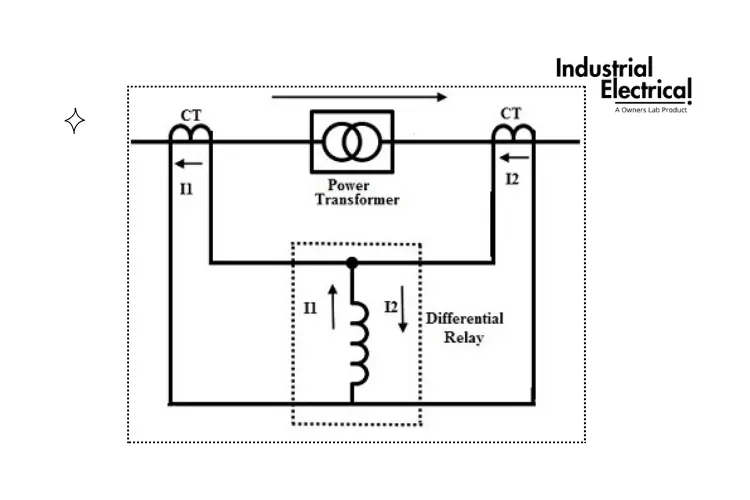
IN THIS ARTICLE
Overview
Working Principle
Application
Advantages
Conclusion
Overview
TOTAL TIME: 5 mins
SKILL LEVEL: : Beginner
Differential relays are critical components in the field of electrical engineering, providing a high degree of reliability and accuracy in protecting electrical systems. They are commonly used in power systems to detect and isolate faults, ensuring minimal disruption to the network and enhancing the safety of equipment and personnel.
What is a differential relay?
A differential relay is a protective device that operates based on the difference in electrical quantities (usually current or voltage) between two points. If the difference exceeds a predetermined threshold, the relay triggers a trip signal to disconnect the faulty section of the system. This principle ensures that only the affected part of the system is isolated, minimizing the impact on the rest of the network.
Read our articles:
How to Identify and Reduce Power Consumption in Industrial Plants
In today’s competitive industrial landscape, reducing energy consumption is not just about cutting costs; it’s about ensuring sustainability and operational efficiency. Power.
Working Principle of Differential Relay
The core concept of a differential relay is based on Kirchhoff’s Current Law (KCL), which states that the sum of currents entering a node must equal the sum of currents leaving the node under normal conditions. A differential relay compares the current entering and leaving a protected zone (e.g., a transformer, generator, or busbar).
-
Normal Operation: Under normal conditions, the current entering and leaving the protected zone are equal, and the relay remains inactive.
-
Fault Condition: If a fault occurs within the protected zone (such as a short circuit or winding fault), the current balance is disturbed. The differential relay detects this imbalance and sends a trip signal to the circuit breaker.
The differential current (∆I) is calculated as:
If exceeds the relay’s set threshold, the relay activates.
Modern differential relays often employ microprocessor-based technology, enabling more precise measurement and additional features like harmonic restraint, which prevents false tripping during transformer inrush conditions.
01
Applications of Differential Relays
Differential relays are widely used in the following scenarios:
- Differential relays protect transformers from internal faults such as winding short circuits and earth faults. They are designed to differentiate between faults and conditions like magnetizing inrush currents.
- These relays safeguard generators from internal faults, including phase-to-phase and phase-to-ground faults.
c)
Busbar Protection:
- Differential relays protect busbars, a critical component in power distribution systems, from faults that could lead to widespread outages.
d)
Motor Protection:
- They are used in large industrial motors to detect and isolate internal faults.
e)
Feeder Protection:
- Differential relays can also protect feeders in complex power systems.
Read our articles:
Electrical Engineering Interview:
When it comes to preparing for interviews in the electrical engineering domain, first-hand experiences can be invaluable. In this blog, we explore the interview journeys of two candidates, Rajarshi Nath Banerjee and Shinjini Singh, as they share insights from their interviews with top companies and PSUs like NALCO, POSOCO, and Tata Power.
02
Leading Manufacturers and Models
Several companies manufacture high-quality differential relays with advanced features to meet modern power system requirements. Here are some prominent manufacturers and their models:
ABB:
Model: RET615
Features: Advanced protection for transformers, high-speed fault detection, and IEC 61850 compliance.
Schneider Electric:
Model: MiCOM P642
Features: Transformer and generator protection, harmonic restraint, and flexible communication protocols.
Siemens:
Model: 7UT85
Features: Multi-winding transformer protection, advanced fault analysis, and easy integration into digital substations.
GE Grid Solutions:
Model: T60 Transformer Protection System
Features: Comprehensive transformer protection, advanced algorithms for fault detection, and IEC 61850 compatibility.
SEL (Schweitzer Engineering Laboratories):
Model: SEL-487E
Features: Differential protection for transformers and generators, harmonic blocking, and cybersecurity features.
03
Advantages of Differential Relays
High Sensitivity: Capable of detecting even small internal faults.
Selective Operation: Only isolates the faulty section, minimizing system disruption.
Fast Response: Ensures quick isolation of faults, reducing potential damage.
Advanced Features: Modern relays offer enhanced functionalities like fault recording, event analysis, and communication capabilities.
Conclusion
Differential relays play a vital role in maintaining the safety and reliability of electrical systems. By detecting and isolating faults promptly, they prevent equipment damage and enhance system stability. With advancements in technology, modern differential relays offer enhanced accuracy, faster response times, and better integration into digital substations, making them indispensable in today’s power systems.
Tips:
Interview Questions on Differential Relays
To prepare for interviews related to differential relays, consider the following questions:
Fundamentals and Principles:
What is the basic principle behind differential relays?
How does Kirchhoff’s Current Law apply to differential relays?
Design and Components:
What are the main components of a differential relay system?
Why are current transformers used in differential relay setups?
Applications:
Where are differential relays commonly used?
How do differential relays differ when used for transformers versus motors?
Operation and Settings:
What factors influence the setting of the threshold in a differential relay?
How does the relay handle false trips caused by CT saturation?
Manufacturers and Models:
Can you name some manufacturers and their popular differential relay models?
What advanced features are available in modern differential relays?
Troubleshooting:
What steps would you take to troubleshoot a malfunctioning differential relay?
How can you verify the correct operation of a differential relay during testing?

